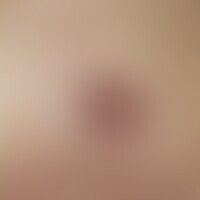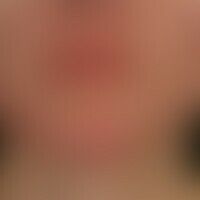
Seborrheic dermatitis of adults L21.9
Dermatitis, seborrheic: Blurred, delicately reddened, coarse lamellar scaling, flat, slightly infiltrated plaques in a 24-year-old female patient.

Folliculitis gramnegative L08.0

Mixed connective tissue disease M35.10
Mixed connective tissue disease: 43-year-old female patient (with clinical aspect of systemic lupus erythematosus) who fulfils the criteria of MCTD: U1.nRNP : titre : >1:1600; characteristics of systemic lupus erythematosus, Raynaud's phenomenon, swollen hands as well as feeling ill, fatigue, proximal muscle weakness (typical myositis symptoms).

Seborrheic dermatitis of adults L21.9
Dermatitis, seborrhoeic. 6-month-old female patient with almost symmetrical, blurred, flatly infiltrated, scaly, non-itching red plaques. good clinical response to steroidal pre-treatment. recurrence of skin symptoms within a few days after discontinuation of therapy.

Erythema perstans faciei L53.83
erythema perstans faciei: symmetric, reddening of both cheeks. is not considered a clinical picture by the patient. furthermore signs of a distinct keratosis pilaris on both upper arms.

Erysipelas A46
Acute erysipelas. acutely appeared, since a few days existing, increasing, flat, sharply defined, pillow-like raised, flaming red and painful swelling of the cheek and the left eye. distinct impairment of the general condition with fever.

Acne papulopustulosa L70.9
Acne papulopustulosa: acne-typical distributed inflammatory papules, few pustules next to older and fresh scars.

Keratoakanthoma (overview) D23.-
Keratoacanthoma: Solitary, 1.5 cm in diameter, spherically bulging, hard, reddish, centrally dented, strongly keratinizing node on the forehead of an 82-year-old patient; the peripheral, wall-like areas of the node are interspersed with telangiectasias and enclose a central, gray-yellow, keratotic plug.

Dyskeratosis follicularis Q82.8
Dyskeratosis follicularis (Darier's disease) Disseminated, yellow-brownish papules and plaques, sometimes covered with small crusts.

Keratoakanthoma (overview) D23.-
Keratoakanthoma, classic type: short term, grown within a few weeks, about 1.8 cm in diameter, hard, reddish, central keratotic nodule with bizarre telangiectasias on the surface, in a 71-year-old female patient.

Acne papulopustulosa L70.9
Acne papulopustulosa:Multiple, inflammatory papules and pustules, some of them crusty, localized periorally and perinasally in the face of a 16-year-old adolescent.

Field carcinogenesis
Field carcinogenesis: preneoplastic skin area with multiple precanceroses, condition after excessive UV-irradiation.

Pityriasis rubra pilaris (adult type) L44.0
Pityriasis rubra pilaris (adult type): relapsing, eythrodermic maximum variant of pityriasis rubra pilaris.

Tinea faciei B35.06
Tine faciei: Plaque that has existed for several months and has been pretreated in different ways and has a pronounced edge.

Lymphomatoids papulose C86.6
lymphomatoid papulosis: previously known recurrent clinical picture in a 34-year-old female patient. rapid, painless knot formation within 14 days. this finding healed spontaneously scarred under central necrosis after 3 months. below the large knot a recently formed new focus.

Folliculitis barbae L73.8
Folliculitis barbae: Chronic, therapy-resistant, inflammatory, itchy (lesions show signs of scratching) follicular papules in the area of the cheeks

Rosacea fulminans L71.8
Rosacea fulminans: a peracute clinical picture with fluking, painful nodules; development of undermined ulcers.

Basal cell carcinoma nodular C44.L
Nodular, extensive ulcerated basal cell carcinoma. since >10 years slowly growing exophytic, non-painful, fleshy tumor which was covered with a compress. marked with arrows, a glassy border wall which is (still) characteristic for advanced basal cell carcinoma.






